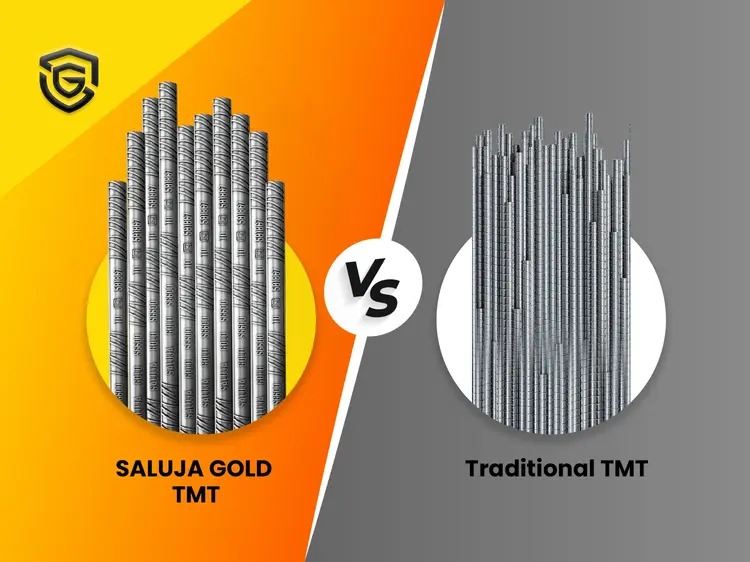Call us: 1800 313 7800

Saluja Gold TMT Bar vs Traditional Steel
Introduction
Steel is the backbone of the construction industry, serving as the primary material in everything from skyscrapers to bridges. Within this realm, two major contenders—TMT bars and traditional steel—compete to meet modern construction demands. In this article, we will explore the differences, advantages, and applications of Saluja Gold TMT bars and traditional steel to help you make an informed choice.
What Are TMT Bars?
Thermo-Mechanically Treated (TMT) bars are high-strength reinforcement bars known for their superior ductility and corrosion resistance. These bars undergo a controlled thermomechanical process to achieve their unique properties.How TMT Bars Are Manufactured
The manufacturing process includes:- Quenching: Rapid cooling of the outer layer of the bar.
- Self-Tempering: The core of the bar remains hot, leading to increased strength.
- Annealing: Gradual cooling ensures flexibility.
What Is Traditional Steel?
Traditional steel refers to unprocessed or minimally processed steel used in construction for decades. It includes plain mild steel bars and other basic forms.Common Types of Traditional Steel- Mild Steel: Known for its ductility.
- Carbon Steel: Offers higher strength but less flexibility.
Saluja Gold TMT Bar vs Traditional Steel: Key Differences
CompositionTMT bars include alloys and are treated to enhance strength, while traditional steel relies on basic iron-carbon compositions.Manufacturing ProcessSaluja Gold TMT bars undergo a three-stage thermomechanical process. Traditional steel manufacturing involves simpler methods such as rolling and casting.
Strength and DurabilitySaluja Gold TMT bars exhibit higher tensile strength and are more durable compared to traditional steel.Mechanical Properties Comparison
Tensile StrengthSaluja Gold TMT bars outperform traditional steel, with strengths ranging from 415MPa to 600 MPa.FlexibilityTraditional steel offers better malleability, but Saluja Gold TMT bars balance flexibility with strength.Corrosion ResistanceThe outer layer of Saluja Gold TMT bars resists corrosion better than traditional steel.Cost Analysis
Initial Cost ComparisonTMT bars are initially more expensive due to their advanced processing.Long-Term Maintenance ExpensesSaluja Gold TMT bars reduce long-term costs due to lower repair and replacement needs.Environmental Impact
Eco-Friendliness of TMT BarsTMT bars are manufactured with lower emissions and higher energy efficiency.Uses of TMT Bars in Construction- High-rise buildings
- Bridges
- Dams
- Small-scale projects
- Temporary structures
Advantages of Saluja Gold TMT Bars
- Lightweight yet strong
- Superior bonding with concrete
- Seismic resistance for earthquake-prone areas
Advantages of Traditional Steel
- Affordable for small-scale projects
- Simple manufacturing processes
- Widely available
Challenges and Limitations
Challenges of Using TMT Bars- Higher initial costs
- Requires skilled labor for handling
- Prone to rust and corrosion
- Lower tensile strength
TMT Bar Grades and Standards
Common Grades of Saluja Gold TMT Bars- Fe 500
- Fe 550
- Fe 550 D
- Fe 600
Why Choose Saluja Gold TMT Bars?
For projects demanding durability, seismic resistance, and longevity, TMT bars are the ideal choice.Why Stick to Traditional Steel?
Traditional steel remains viable for specific use cases like small-scale or temporary projects.Major infrastructure projects like metro systems and skyscrapers rely on TMT bars.Challenges Faced with Traditional SteelInstances of corrosion and failure highlight its limitations in modern construction.FAQs
What Is the Lifespan of Saluja Gold TMT Bars?
Saluja Gold TMT bars can last over 50 years with minimal maintenance.
Are Saluja Gold TMT Bars Cost-Effective?
Yes, while initially expensive, their longevity makes them cost-effective in the long run.
Can Traditional Steel Be Used for Large Projects?
It’s not ideal due to lower tensile strength and durability.
Which Is Better for Earthquake-Prone Areas?
Saluja Gold TMT bars are superior due to their seismic resistance.
How Are Saluja Gold TMT Bars Environmentally Friendly?
Because, our production emits fewer greenhouse gases and consumes less energy.
Are There Different Grades of Saluja Gold TMT Bars?
Yes, common grades include Fe 500, Fe 550, Fe 550 D & Fe 600.


